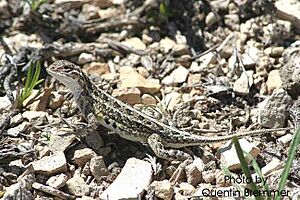Lesser earless lizard facts for kids
Quick facts for kids Lesser earless lizard |
|
|---|---|
 |
|
| Conservation status | |
| Scientific classification | |
| Genus: |
Holbrookia
|
| Species: |
maculata
|
The lesser earless lizard (scientific name: Holbrookia maculata) is a type of lizard that lives in North America. You can find these small lizards in the southwestern and central parts of the United States. They also live in northern Mexico. There are eight different kinds, or subspecies, of this lizard.
Contents
About the Lesser Earless Lizard
The lesser earless lizard is a small reptile. Adults usually grow to be about 4 to 5 inches (10 to 13 cm) long, including their tail. Their skin has smooth, tiny scales on their back.
One interesting thing about these lizards is their name: "earless." This is because they don't have outside ear openings like many other animals. They do have two folds of skin under their throat. During the time when females are ready to lay eggs, their throat turns orange. The underside of their tail does not have any dark spots.
Where They Live and What They Like
You can find the lesser earless lizard in many U.S. states. These include Arizona, Colorado, Kansas, Oklahoma, Nebraska, New Mexico, South Dakota, Texas, Utah, and Wyoming. They also live in several Mexican states, such as Chihuahua, Coahuila, Durango, Guanajuato, Jalisco, Nuevo León, San Luis Potosí, Sinaloa, Sonora, and Zacatecas.
These lizards prefer to live in places with shrubland, grassland, and desert areas. They like open spaces where they can move around easily.
Life and Habits
The lesser earless lizard is an oviparous animal. This means the female lizard lays eggs, instead of giving birth to live young.
When it comes to food, these lizards are insect eaters. They mostly prey on insects and spiders. They are good at hunting down their meals in their natural habitat.
Different Kinds of Lesser Earless Lizards
Scientists recognize eight different types, or subspecies, of the lesser earless lizard. Each one has slight differences and might live in a specific area. Here are some of them:
- H. m. bunkeri – Bunker's earless lizard
- H. m. campi
- H. m. dickersonae – Dickerson's earless lizard
- H. m. flavilenta
- H. m. maculata – northern earless lizard
- H. m. perspicua – eastern earless lizard, prairie eastern lizard
- H. m. pulchra – Huachuca earless lizard
- H. m. ruthveni – bleached earless lizard (found in New Mexico's White Sands)


